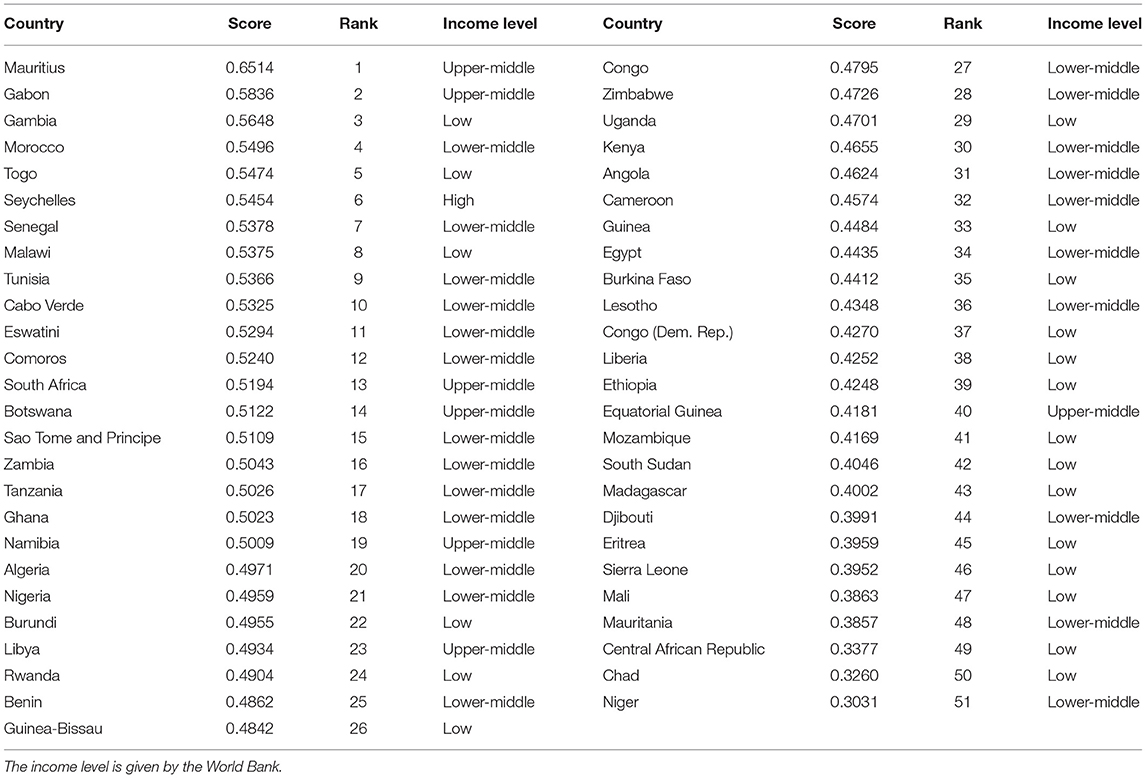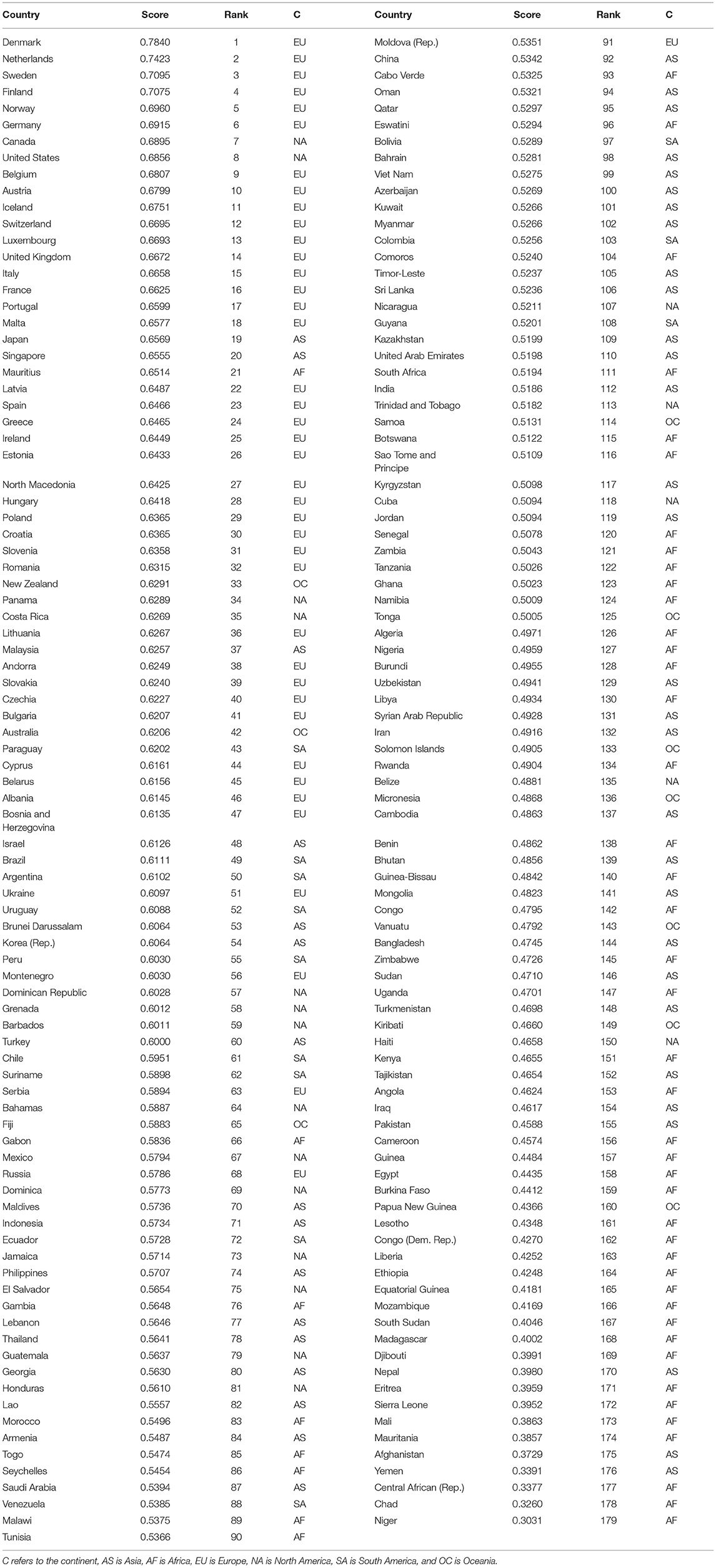- 1Department of Finance, School of Economics, Liaoning University, Shenyang, China
- 2Department of Economics, School of Economics and Management, Zhejiang Sci-Tech University, Hangzhou, China
- 3North China University of Water Resources and Electric Power, Zhengzhou, China
- 4Department of Business Administration, Cheng Shiu University, Kaohsiung, Taiwan
- 5Center for Environmental Toxin and Emerging-Contaminant Research, Cheng Shiu University, Kaohsiung, Taiwan
- 6Super Micro Mass Research and Technology Center, Cheng Shiu University, Kaohsiung, Taiwan
Sustainable development (SD) has increasingly played a key background role in government policymaking across the world, especially for the least developed countries in Africa. Therefore, the purpose of our research is to study the SD of African countries in public life, education, and welfare, and then to help policy makers better monitor the status of sustainable development and formulate development policies in these aspects. We firstly propose a new method to assess the SD in public life, education, and welfare. Then we assess the SD status in 51 African countries as well as other countries in the world. After that, we also make a comparison between African countries and the countries in other continents.
Introduction
Since the UN 2030 Agenda and Sustainable Development Goals (SDGs) were adopted by all 193 member states, governments and researchers are increasingly trying to monitor performance in sustainability (1). The monitoring of sustainable development (SD) performance has made it necessary to construct a composite index system (2). A composite index, which can evaluate national SD comprehensively and objectively, will not only provide comprehensive status of sustainability, but also provide a policy basis for governments to formulate and implement public policies (3).
As reviewed in the next section, a list of indices have been proposed for sustainability assessment, and it was found that the SD performance of African countries is at the lowest level in the world (4–7). Moreover, most of the existing studies have pointed out improving the SD level of African countries is the key to achieving the global SDGs, and Africa is the continent which needs the most attention (3). The reason is that the leading SD countries have achieved a high SD level, the countries with medium SD level have found a way to increase SD, while the low SD countries (mainly in Africa) are still unable to prosper (1).
At present, many literature papers have studied the SD of African countries, especially in the aspects of governance, economy, resources, and environment, like Selmier and Newenham-Kahindi (8), Mutiiria et al. (9), Asongu and Nnanna (10), and Liyanage et al. (11), but the research on public life, education, and welfare is not enough. For example, Atisa et al. (12) studied legal structures, governance, and sustainable development in African countries.
Therefore, this paper aims to study the SD of African countries in public life, education, and welfare, so as to help governments to monitor the status of sustainability and formulate sustainable development policies in these aspects. We firstly propose a new method for the assessment of SD in public life, education, and welfare based on existing studies. Then we assess and analyze the SD of African countries with these aspects in mind. After that, we also make a comparison between African countries and other countries in the world.
The rest of the paper is organized into five sections. Section Literature Review is the literature review. Section Methods and Data describes the method for the assessment of SD in public life, education, and welfare, as well the data source. Section Results includes the results. Section Discussion: A Comparison Between African and Other Countries compares the SD of African countries and that of other countries. Section Conclusion concludes the findings.
Literature Review
The Concept of Sustainable Development
The concept of sustainable development originated from ecology, but with the progress of related studies, it gradually evolved into a comprehensive concept including economy, society, and environment. Sustainable development has become the focus of global attention and controversy, especially after the Our Common Future report from the Brundtland Commission (13). The report defines sustainable development as development that meets the needs of the present generation without compromising the needs of the future generation. It may be considered as the first definition of sustainable development, emphasizing its intergenerational and ecologically oriented aspect (2). Although the concept of sustainable development originated from ecology, it has brought together many disciplines and interests, involving ecology together with environmental, economic, and societal aspects (14, 15). And sustainable development is also considered as a cross-cutting concept which includes three dimensions, namely social, economic, and environment aspects (16). As Guillén-Royo (17) has pointed out, sustainable development demands action on its three dimensions by development policies fostering economic growth, greater social equality, and the reduction of negative environmental impacts. Kwatra et al. (18) put forward a similar concept, sustainable development is a multi-dimensional concept, which emphasizes integration and striking a dynamic balance between economic, social, and environmental aspects in a region to ensure inter-generational and intragenerational equity. In recent years, although sustainable development is defined slightly differently by various researchers, it is the general trend that sustainable development is a concept including three dimensions of economy, society, and environment. As Jin et al. (3) concluded, sustainable development is to coordinate economic, social, and environmental development, so as to balance the intra-generational welfare, and then maximize the total welfare of generations.
Indices for Sustainable Development Assessment
After the concept of sustainable development was put forward, a growing list of studies were devoted to building a composite index for sustainability assessment. There are many classic and well-known examples, like the Index of Sustainable Economic Welfare (19, 20), ecological footprint (21), genuine savings (22), Environmental Sustainability Index (23), Environmental Performance Index (2006), and so on. In addition, many widely referenced sustainable development indices are constructed by international organizations, such as the UN's Sustainable Development Goals Index (24) and the United Nations Development Program's (25) Human Development Index (HDI).
The Human Development Index (HDI) is the one of the most widely used and referenced indices (26). The HDI is an excellent index, and famous for its simple composition, representative sub-indicators, and rich connotation (7). It consists of three equal-weighted indicators: income, life expectancy, and education. But the HDI is criticized and even suspected of not being a “strict” sustainable development index, because it does not have indicators on environmental and resource dimensions (6, 27).
Therefore, some studies put forward modified indices for the HDI by adding indicators of resource and environment, such as the Human Sustainable Development Index (HSDI) constructed by Bravo (6), Human Green Development Index (HGDI) by Li et al. (5), and the National Sustainable Development Index (NSDI) by Jin et al. (3). The HSDI, HGDI, and NSDI are all regarded as “modified indices” or improved schemes of the HDI, but they are quite different in composition and connotation. Among these modified indices of the HDI, the NSDI is considered as a relatively complete indicator, and more in line with the concept of sustainable development (28).
Methods and Data
The Assessment Framework of SD in Public Life, Education, and Welfare
In order to assess sustainable development in public life, education, and welfare, we adopt the social dimension of the National Sustainable Development Index (see Table 1). The NSDI was built with 12 indicators in economic, social, and environmental dimensions based on the concept of sustainable development (3). Sustainable development is to coordinate economic, social, and environment development, and balance the intra-generational welfare, so as to maximize the total welfare of generations (17, 18). In other words, the government should set sustainable development as a comprehensive goal including economic, social, and environmental dimensions (16). So, governments should pursue a relatively high and fair income for citizens, a potential for economic growth, and a reasonable economic structure to improve the welfare of the present generation, in the economic dimension. From the resource and environmental dimension, the climate and air quality not only reflect the living conditions and quality of human beings in the present generation, but also affect that of future generations, while forests, arable land, and energy consumption represent the current resource and environmental conditions, and affect the performance of economic activities. And in the social dimension, governments should not only improve social welfare, but should also consider social fairness and harmony, thus education for the young, medical treatment for the sick, basic sanitation, and drinking water should be guaranteed. Therefore, Jin et al. (3) suggest that the NSDI should contain these factors, namely “economic growth,” “income level,” and “economic structure” in the economic dimension, “climate,” “air quality,” “forest,” “arable land,” and “energy” in the resource and environmental dimension, and “education,” “health,” “drinking water,” and “sanitation facilities” in the social dimension. And they should select the corresponding indicators for each factor, based on the principles of representativeness, comparability, and data availability. So, we choose the social dimension of the NSDI to study the SD in public life, education, and welfare for Africa countries.
Normalization
Normalization is a necessary step before the four indicators are aggregated into a composite index. There are many kinds of normalization methods, such as “ranking,” “distance to target,” “Z-Score,” and “min-max” (29, 30). We adopt the min-max method for normalization, because it is simple, established, and widely used (6, 31). According to the min-max method, we divide the four indicators into positive indicators and negative indicators (as shown in the last column of Table 1). Positive indicators are those whose increasing values represent better performance in sustainable development, such as life expectancy. Since the four indicators are all positive, the min-max normalization formula for the positive indicator is shown in Equation (1).
In the equation above, X is the raw data value, min(X) is the minimum observed value of the indicator, max(X) is the maximum observed value of the indicator, Xij is the indicator j of country i, and is the result of normalization.
Weighting for Four Indicators
Weighting is another important step to aggregate all indicators into a sustainable development index. There are some popular weighting methods presented in existing studies, such as equal weights, factor analysis, expert weights, and the entropy method (3, 5, 29, 31). But these methods have limitations in varying degrees. For example, equal weights mean that the weights of all indicators are equal, but the importance of different indicators for sustainable development is obviously different. Similarly, the expert weights method also lacks objectivity (5). And the factor analysis can only estimate weights if correlation exists between indicators (31). The entropy method is considered as an objective weighting technique in sustainable development studies (32).
We use the entropy method to weight each indicator. The entropy method is a weighting technique based on the idea of entropy from information theory. Specifically, information is a measure of the order degree and entropy is a measure of the disorder degree in a system; hence, the smaller the entropy of the indicator, the more information provided by the indicator, and the greater its role and weight in the comprehensive evaluation (32, 33). As Zhang et al. (33) have pointed out, the weight measured by the entropy method represents the relative rate of change of the indicator in a composite index system, while the relative level of each indicator should be calculated by the standardized value of its data. Thus, the entropy method is an objective weighting technique that makes weight judgments based on the size of the data information load. It can reduce the influence of human subjectivity on the evaluation results and makes the evaluation results more realistic (32, 34).
According to the principle of the entropy method, we first normalize each index, as shown in Equation (1). Thus, the entropy value ej of indicator j could be obtained, as shown in Equations (2) and (3).
The information utility value of indicator j is calculated, namely gj in Equation (4).
Finally, we can get the weight of indicator j, namely ωj, as shown in Equation (5).
Data Source and Imputation
We chose to assess the SD in public life, education, and welfare for 179 countries in 2015 (the list of countries is shown in Table 4), and then focus on the 51 African countries. These countries were selected by two criteria: (1) all countries had published data of all four indicators (see Table 2); (2) internationally recognized non-sovereign entities were not selected, such as Hong Kong, China. In general, the 179 selected samples included most countries, covering more than 90% of the population and land in the world.
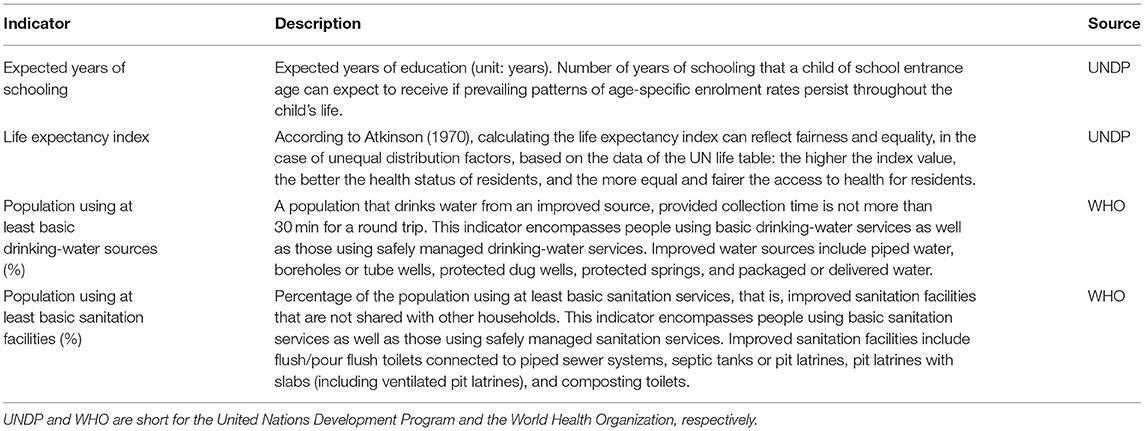
Table 2. The descriptions and data sources of the four indicators in the social dimension of the NSDI.
Due to the missing data of some indicators in some countries, this paper adopts a different imputation method to fill missing data. The current studies prefer to adopt the imputation method to fill missing data rather than missing out information. This notion is also in tune with works by Campagnolo et al. (35). This paper adopts different imputation methods following the actual situation. Firstly, we use the mean value interpolation method. For example, if the data of 2014 and 2016 are available, but the data of 2015 are missing, we use the average value of 2014 and 2016 to replace the value of 2015. Secondly, we use the nearest neighbor interpolation method. This method is used to dealing with missing data for the variables that are very stable over time. These imputations in instances can distort the results but losing out on data might prove costly to some countries (31).
Results
This paper measures the weight of four indicators with the entropy method (see the last column of Table 3). As a result, the weights of “education,” “health,” “drinking water,” and “sanitation facilities,” respectively accounted for 36.36, 35.09, 14.60, and 13.95%. It means that education is the most important factor for sustainable development in public life, education, and welfare. And education is as important as health.
According to the weights in Table 3, we aggregate the four indicators into a composite index, and assess the SD score for 51 Africa countries as well the other countries (see Table 4 and Appendix Table A1). As a result, the SD score of each country is ranged from 0 to 1. The SD score of each Africa country is shown in Table 4, the top five countries are Mauritius (0.6514), Gabon (0.5836), Gambia (0.5648), Morocco (0.5496), and Togo (0.5474), while the bottom five countries are Mali (0.3863), Mauritania (0.3857), Central African Republic (0.3377), Chad (0.3260), and Niger (0.3031).
The SD score of each country showed distinct characteristics in income level. These countries are divided into four categories according to income levels following the World Bank's standard, namely high, upper-middle, lower-middle, and low income countries. As Table 4 shows, countries with higher SD score tended to be have a higher income level. For example, there are only three low-income countries in the top 20, while 13 low-income countries are in the bottom 20. This means that there may be a positive correlation between income level and SD score. The main reasons are: (1) Those low-income countries have very limited fiscal revenue, leading to insufficient supply of public goods, such as education, medical care, public health, etc. (36); (2) Some low-income countries lack a systematic and efficient public management system, which makes the supply of public goods inefficient (28).
Figure 1 shows the geographical distribution of SD score in Africa. It should be noted that the darker the blue, the higher the SD score and SD performance in public life, education, and welfare. The countries in North and South Africa have the deepest blue and the highest SD score, such as South Africa and Morocco. On the contrary, central African countries north of the equator have the lightest blue and the lowest SD score, which means that SD performance is at the bottom level, such as in Central African Republic, Chad, and Niger. In sum, the geographical distribution of SD score shows that SD is high in South and North Africa, while low in the middle.
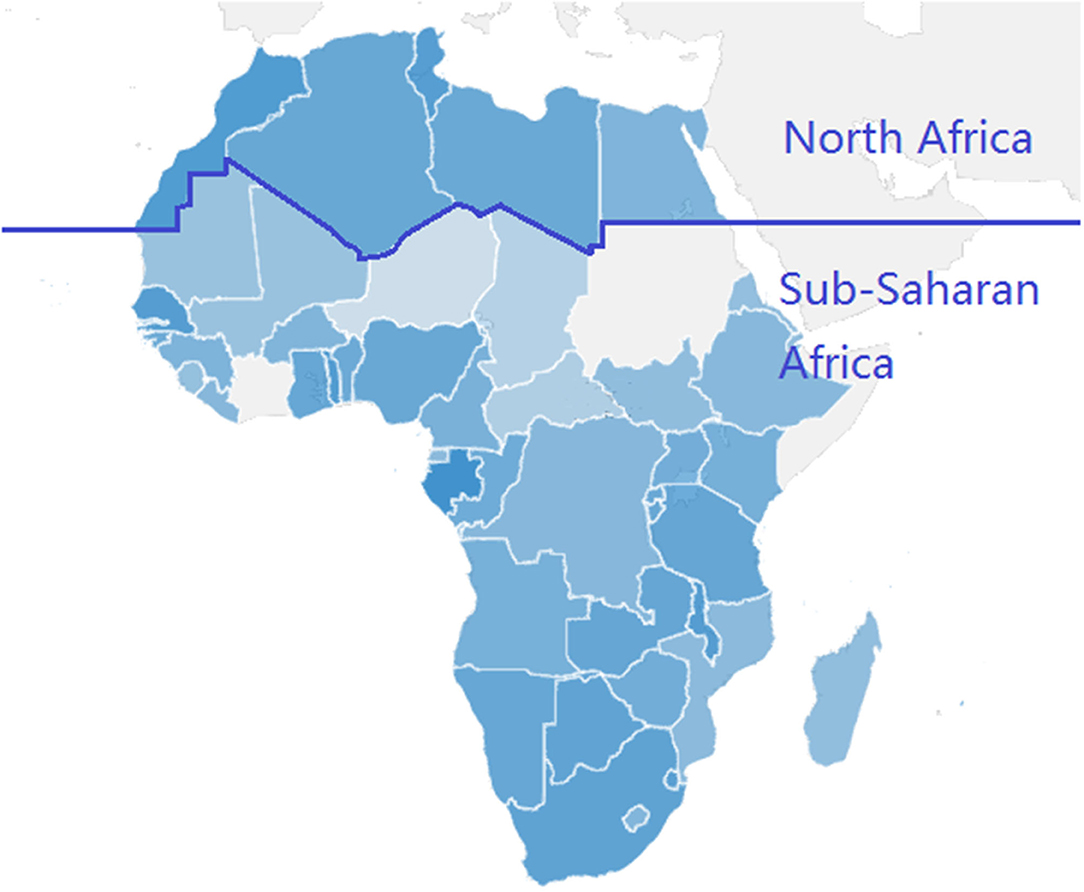
Figure 1. Geographical distribution of SD score in Africa. (1) The darker the blue, the higher the SD score of the country, while gray indicates missing data. (2) Above the dark blue dividing line are North African countries, and below are Sub-Saharan African countries.
In addition, we can find the different characteristics of SD status between North African and Sub-Saharan African countries. As Figure 1 shows, above the dark blue dividing line are North African countries, and below are Sub-Saharan African countries. First, the SD performance of North African countries is obviously better than that of Sub-Saharan African countries. This is not only because it is adjacent to the Mediterranean and the climate environment is conducive to survival and development, but also because it is close to those European countries with prosperous economy and society. Second, among Sub-Saharan African countries, the SD score increases from north to south. One of the important reasons is geographical location and climatic environment. And another more important reason is that the countries in the south have established a relatively mature political and institutional system, especially in South Africa.
Discussion: A Comparison Between African and Other Countries
The SD scores of 179 countries are shown in Figure 2 and Appendix Table A1. As a result, the top 10 countries are Denmark (0.7840), the Netherlands (0.7423), Sweden (0.7095), Finland (0.7075), Norway (0.6960), Germany (0.6915), Canada (0.6895), the United States (0.6856), Belgium (0.6807), and Austria (0.6799), while the bottom 10 countries are Nepal (0.3980), Eritrea (0.3959), Sierra Leone (0.3952), Mali (0.3863), Mauritania (0.3857), Afghanistan (0.3729), Yemen (0.3391), Central African (0.3377), Chad (0.3260), and Niger (0.3031).
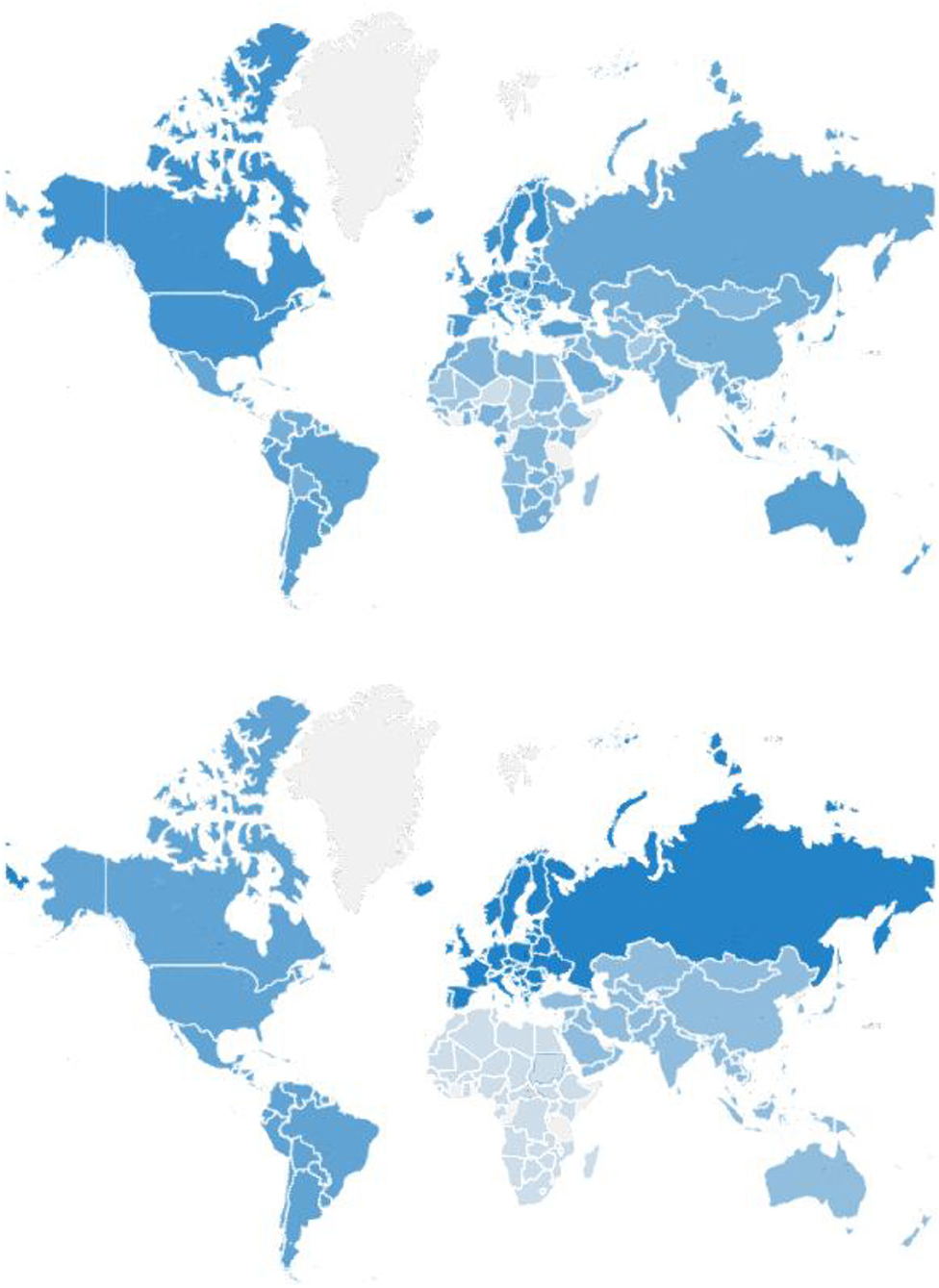
Figure 2. SD score for each country (upper) and continent (lower). The darker the blue, the higher the mean SD score of the country (upper) or the continent (lower).
The SD score and ranking of each country show distinct characteristics. Most of the high-SD countries are in Europe and North America. The countries with a low SD score are mainly in Africa and Asia. In addition, we find that all the developed countries1 are high SD score countries, and most of them are ranked in the top 30, while most of the bottom 30 countries are developing countries in Africa.
There are three main reasons for the poor SD performance in developing countries. First, the level of economy and residents' income is relatively low. Second, the supply of public goods and services is insufficient and inefficient, like education, public health, and environmental protection, due to poor governments or inadequate fiscal revenue (36). Lastly, some developing countries, such as China, are bombarded with such problems as inadequate management and technology of pollution control and resource utilization, while still promoting economic growth at all costs, which damages national sustainable development (3).
The geographical distribution of the SD score is shown in Figure 2. As the figure shows, the darker the blue, the higher the NSDI of the country and the better its performance in sustainable development, while the white indicates missing data. We find that European and North American countries have the highest average SD scores, Africa the lowest, and South America and Asia in the middle.
There is an important reason for that geographical distribution. On the one hand, the countries with a higher economic level always maintain a good performance in sustainable development, because of their established and sound system in public management. On the other hand, those low-income countries not only have a poor economic foundation, but also do not have the above conditions, so they always find it difficult to improve SD performance. Some countries have even been mired in war and extreme poverty.
Conclusion
This paper aims to study the SD of African countries in public life, education, and welfare, so as to help policy makers better monitor the status of sustainable development and formulate development policies. So, we firstly proposed a new method for the assessment of SD in public life, education, and welfare, and then assessed and analyzed the SD of African countries in these aspects. We found that: (1) there was a positive correlation between income level and SD across African countries; (2) most SD leading countries were in South and North Africa, while most low SD countries were in the middle; and (3) there were different characteristics of SD status between North African and Sub-Saharan African countries.
There is an important research question that needs to be discussed: how to improve the sustainable development level of those low-SD African countries and narrow the development gap among countries? Especially for the Sub-Saharan countries with poor performance in public life, education, and welfare. The cases of North African countries and South Africa may be a reference for those Sub-Saharan countries. Except for natural endowments such as climate, environment, and geographical location, many aspects of North African countries are worthy of reference. First, for those countries still in political chaos, the establishment of a stable political power is the basis of all development. Second, following the practices of European and other developed countries, establishing and improving the judicial, economic, and fiscal institutional systems in combination with the characteristics and development situation of their own countries is vital. After that, taking economic growth as the first priority of national development, and establishing economic and trade cooperation with Europe, the United States, China, and other more developed countries is needed. Lastly, when the economic and income level reaches a certain stage, the government should pay more attention to sustainable development in public life, education, and welfare.
Data Availability Statement
The original contributions presented in the study are included in the article/Supplementary Material, further inquiries can be directed to the corresponding authors.
Author Contributions
DL conceived and designed the research, provided guidance throughout the entire research process, and responsible for all R&R works. DL and GH wrote and supplemented the English paper. HJ participated in data analysis. F-ST reviewed and edited the paper. All authors contributed to the article and approved the submitted version.
Funding
The authors acknowledge funding support from the Major Program Project of the National Social Science Fund of China (No: 19ZDA055), Zhejiang Sci-Tech University (ZSTU) Scientific Research Fund (No: 21092117-Y), and the Prosperity Plan of Philosophy and Social Science Research of ZSTU (No: 21096075-Y).
Conflict of Interest
The authors declare that the research was conducted in the absence of any commercial or financial relationships that could be construed as a potential conflict of interest.
Publisher's Note
All claims expressed in this article are solely those of the authors and do not necessarily represent those of their affiliated organizations, or those of the publisher, the editors and the reviewers. Any product that may be evaluated in this article, or claim that may be made by its manufacturer, is not guaranteed or endorsed by the publisher.
Acknowledgments
The authors would like to express sincere gratitude to Giangiacomo Bravo from Linnaeus University, Vladimir Strezov from Macquarie University, and the peer reviewers, for their valuable suggestions. F-ST acknowledges a distinguished (visiting) professorship from the NCWREP.
Supplementary Material
The Supplementary Material for this article can be found online at: https://www.frontiersin.org/articles/10.3389/fpubh.2021.748845/full#supplementary-material
Footnote
1. ^According to the standards of the CIA's World Fact Book and IMF.
References
1. Hametner M, Kostetckaia M. Frontrunners and laggards: how fast are the EU member states progressing towards the sustainable development goals? Ecol Econ. (2020) 177:106775. doi: 10.1016/j.ecolecon.2020.106775
2. Alaimo LS, Maggino F. Sustainable development goals indicators at territorial level: conceptual and methodological issues-the Italian perspective. Soc Indic Res. (2020) 147:383–419. doi: 10.1007/s11205-019-02162-4
3. Jin H, Qian X, Chin T, Zhang H. Global assessment of sustainable development: based on the modification of human development index with entropy method. Sustainability. (2020) 12:1–20. doi: 10.3390/su12083251
4. Bilbao-Ubillos J. The limits of human development index: the complementary role of economic and social cohesion, development strategies and sustainability. Sustain Dev. (2013) 6:400–12. doi: 10.1002/sd.525
5. Li XX, Liu YM, Song T. Calculation of the green development index. Soc Sci China. (2014) 6:69–95.
6. Bravo G. The human sustainable development index: new calculations and a first critical analysis. Ecol Indic. (2014) 37:145–50. doi: 10.1016/j.ecolind.2013.10.020
7. Hickel J. The sustainable development index: measuring the ecological efficiency of human development in the Anthropocene. Ecol Econ. (2019) 167:106331. doi: 10.1016/j.ecolecon.2019.05.011
8. Selmier WT, Newenham-Kahindi A. Communities of place, mining multinationals and sustainable development in Africa. J Clean Prod. (2020) 292:125709. doi: 10.1016/j.jclepro.2020.125709
9. Mutiiria OM, Ju Q, Dumor K. Sustainable development in Sub-Saharan Africa: the impact of infrastructure on wealth per capita. Int Soc Sci J. (2020) 69:1–14. doi: 10.1111/issj.12226
10. Asongu S, Nnanna J. Inclusive human development in Sub-Saharan Africa. J Enterp Communities. (2020) 14:183–200. doi: 10.1108/JEC-11-2019-0115
11. Liyanage S, Netswera FG, Motsumi A. Insights from EU policy framework in aligning sustainable finance for sustainable development in Africa and Asia. IJEEP. (2021) 11:459–70. doi: 10.32479/ijeep.9865
12. Atisa G, Zemrani A, Weiss M. Decentralized governments: local empowerment and sustainable development challenges in Africa. Environ Dev Sustain. (2021) 23:3349–67. doi: 10.1007/s10668-020-00722-0
13. World Commission on Environment Development (WCED). Our Common Future. Oxford, UK: University Press (1987).
14. Ramos TB, Caeiro S. Meta-performance evaluation of sustainability indicators. Ecol Indic. (2010) 2:157–66. doi: 10.1016/j.ecolind.2009.04.008
15. Bolcárová P. KološTa S. Assessment of sustainable development in the EU 27 using aggregated SD index. Ecol Indic. (2015) 48:699–705. doi: 10.1016/j.ecolind.2014.09.001
16. Goodland R, Daly H. Environmental sustainability: universal and non-negotiable. Ecol Appl. (1996) 6:1002. doi: 10.2307/2269583
17. Guillén-Royo M. Sustainability and wellbeing: Human-scale development in practice. London, UK: Routledges (2016).
18. Kwatra S, Sharma P, Kumar A. A critical review of studies related to construction and computation of Sustainable Development Indices. Ecol Indic. (2020) 112:106061. doi: 10.1016/j.ecolind.2019.106061
20. Cobb CW, Cobb JB. The Green National Product: A Proposed Index of Sustainable Economic Welfare. Lanham, MD, USA: University Press of America (1994).
21. Wackernagel M, Rees W. Our Ecological Footprint. Basel, Switzerland: Birkhouse Publishing (1997).
22. Hamilton K, Atkinson G, Pearce DW. Genuine Savings as an Indicator of Sustainability. Norwich, UK: CSERGE Working Paper GEC97-03; GSERGE (1997).
23. Esty DC, Levy MA, Srebotnjak T, Sherbinin D. Environmental Sustainability Index: Benchmarking National Environmental Stewardship. New Haven, CT, USA: Yale Center for Environmental Law Policy (2005).
25. United Nations Development Programme (UNDP). Note on Statistics in the Human Development Report. New York, NY, USA: UNDP (2004).
26. Estoque RC, Murayama Y. Social–ecological status index: a preliminary study of its structural composition and application. Ecol Indic. (2014) 43:183–94. doi: 10.1016/j.ecolind.2014.02.031
27. Ture C. A methodology to analyse the relations of ecological footprint corresponding with human development index: eco-sustainable human development index. Int J Sustain Dev World Ecol. (2013) 1:9–19. doi: 10.1080/13504509.2012.751562
28. Jin H, Jorge Martinez-Vazquez. Sustainable Development and the Optimal Level of Fiscal Expenditure Decentralization. Georgia, USA: ICePP Working Paper Series, #2103, Andrew Young School of Policy Studies, Georgia State University (2021).
29. Nardo M, Saisana M, Saltelli A, Tarantola S, Hoffman A, Giovannini E. Handbook on Constructing Composite Indicators: Methodology and User Guide (2005).
30. Pollesch NL, Dale VHN. sustainability assessment: methods and implications. Ecol Econ. (2016) 130:195–208. doi: 10.1016/j.ecolecon.2016.06.018
31. Khalid AM, Sharma S, Dubey AK. Data gap analysis, indicator selection and index development: a case for developing economies. Soc Indic Res. (2020) 148:893–960. doi: 10.1007/s11205-019-02225-6
32. Wang M, Zhao X, Gong Q, Ji Z. Measurement of regional green economy sustainable development ability based on entropy weight-topsis-coupling coordination degree: a case study in Shandong Province, China. Sustainability. (2019) 1:280–95. doi: 10.3390/su11010280
33. Zhang WM, An JW, Han C. The application of entropy method in the evaluation of urban sustainable development. J Quant Tech Econ. (2003) 6:115–8.
34. Ma YM, Wu YM, Wu BJ. Comprehensive evaluation of sustainable urban development of Yangtze River delta based on entropy method and quadrant method. Econ Geogr. (2015) 6:47–53.
35. Campagnolo L, Eboli F, Farnia L, Carraro C. Supporting the UN SDGs transition: methodology for sustainability assessment and current worldwide ranking. Economics. (2018) 12:1–31. doi: 10.5018/economics-ejournal.ja.2018-10
36. Jin H, Qian X. How the Chinese government has done with public health from the perspective of the evaluation and comparison about public-health expenditure. Int J Environ Res Public Health. (2020) 17:1–16. doi: 10.3390/ijerph17249272s
Appendix
Keywords: sustainable development, education, welfare, Africa, public life
Citation: Li D, He G, Jin H and Tsai F-S (2021) Sustainable Development of African Countries: Minding Public Life, Education, and Welfare. Front. Public Health 9:748845. doi: 10.3389/fpubh.2021.748845
Received: 28 July 2021; Accepted: 06 September 2021;
Published: 11 November 2021.
Edited by:
Michael Ekubu Otim, University of Sharjah, United Arab EmiratesCopyright © 2021 Li, He, Jin and Tsai. This is an open-access article distributed under the terms of the Creative Commons Attribution License (CC BY). The use, distribution or reproduction in other forums is permitted, provided the original author(s) and the copyright owner(s) are credited and that the original publication in this journal is cited, in accordance with accepted academic practice. No use, distribution or reproduction is permitted which does not comply with these terms.
*Correspondence: Danyang Li, bGlkeTA1MzIwMzAyQGdtYWlsLmNvbQ==
 Danyang Li
Danyang Li Guosheng He1
Guosheng He1 Hui Jin
Hui Jin Fu-Sheng Tsai
Fu-Sheng Tsai

